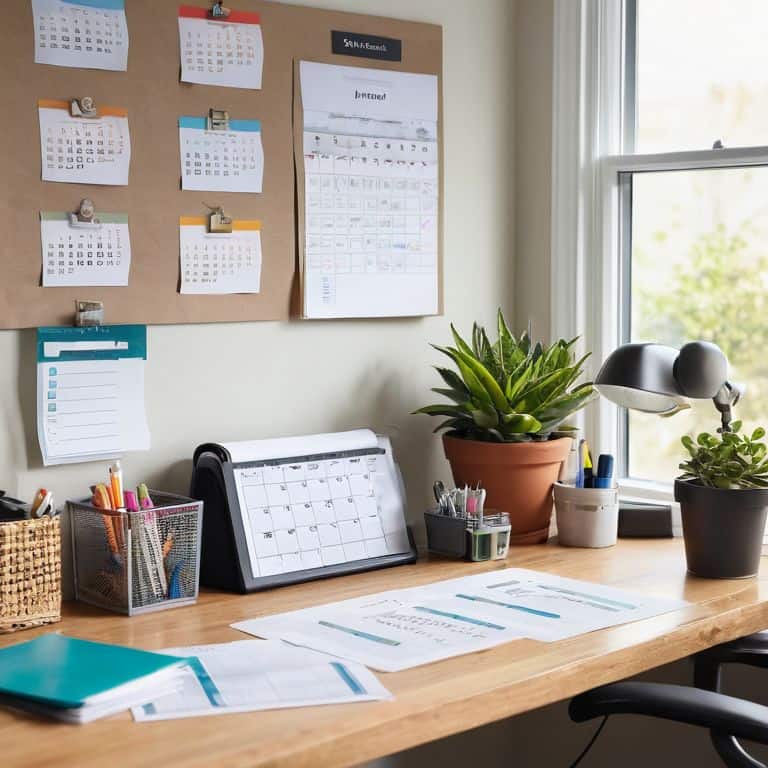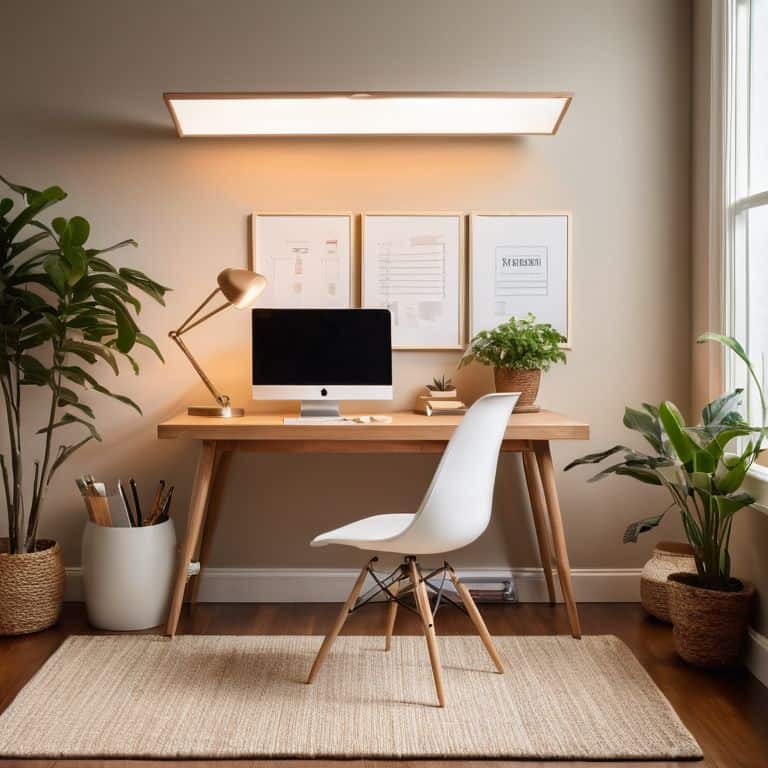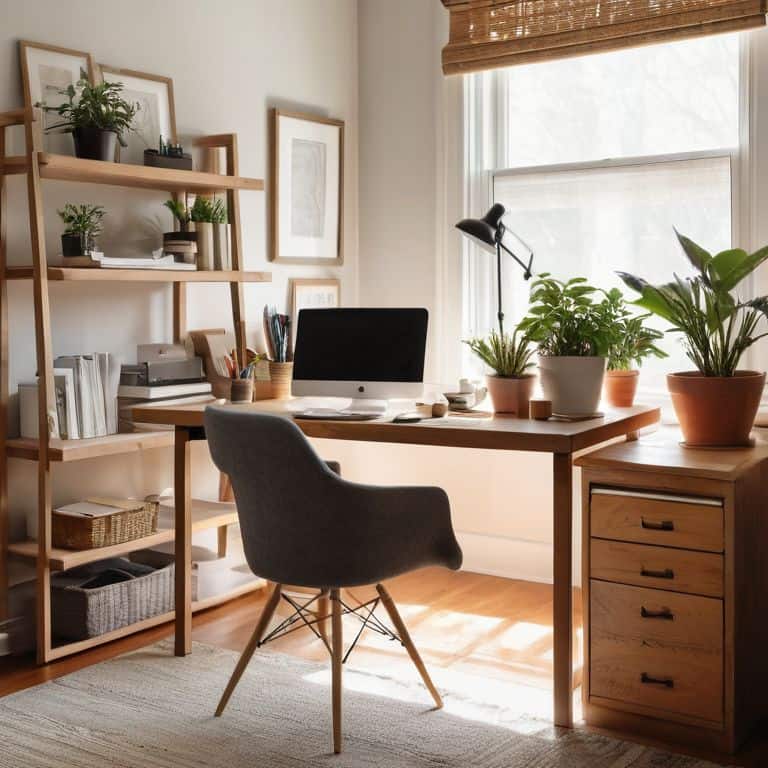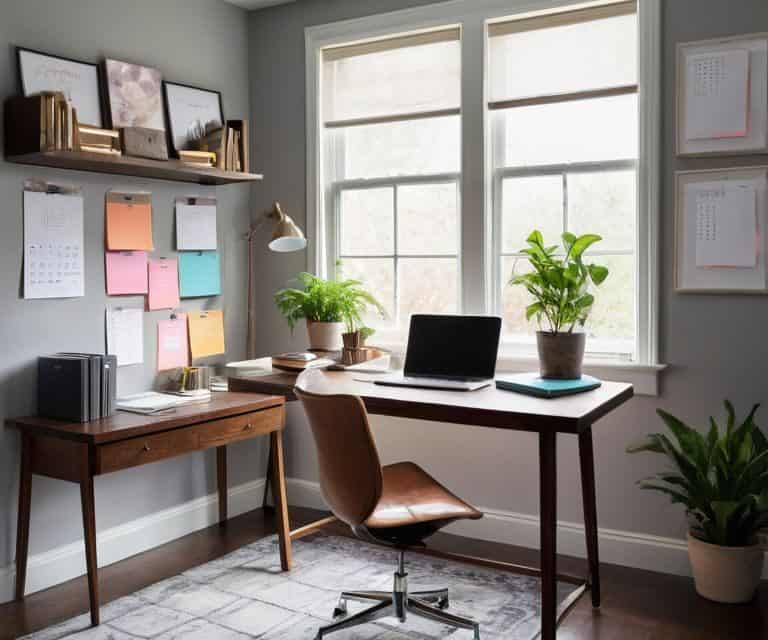I still remember the day I realized that my cluttered home office was suffocating my productivity. I was trying to meet a tight deadline, but my workspace was a mess – papers scattered everywhere, coffee cups piling up, and a desk that seemed to be sinking under the weight of my to-do list. It was then that I stumbled upon the truth about how to organize your home office for productivity: it’s not just about tidying up, it’s about creating a space that fuels your focus and helps you get stuff done.
In this article, I’ll share my hard-won lessons on how to transform your home office into a productivity powerhouse. You’ll learn how to ditch the distractions, create a functional workflow, and make the most of your time. I’ll give you practical, no-nonsense advice on how to organize your home office for productivity, from decluttering and minimalism to clever storage solutions and ergonomic hacks. Whether you’re a freelancer, entrepreneur, or remote worker, this guide will help you create a space that inspires your best work and sets you up for success.
Table of Contents
- Guide Overview: What You'll Need
- Step-by-Step Instructions
- How to Organize Your Home Office for Productivity
- From Clutter to Clarity: 5 Essential Tips to Supercharge Your Home Office
- Key Takeaways to Boost Your Productivity
- The Productivity Catalyst
- Wrapping Up: Your Path to a Productive Home Office
- Frequently Asked Questions
Guide Overview: What You'll Need

Total Time: 2 hours 30 minutes
Estimated Cost: $50 – $100
Difficulty Level: Intermediate
Tools Required
- Label Maker (for labeling files and folders)
- Tape Measure (for measuring desk and shelf space)
- Level (for ensuring shelves are straight)
- Screwdriver (for assembling furniture)
- Pencil and Paper (for planning and sketching out the space)
Supplies & Materials
- File Organizer (for keeping important documents in order)
- Desk Tray (for keeping office supplies within reach)
- Shelving Unit (for storing books and office equipment)
- Cable Management System (for keeping cords and cables organized)
- Ergonomic Accessories (such as a keyboard tray or a back support)
Step-by-Step Instructions
- 1. First, let’s get real about our home offices – they’re often a reflection of our minds: cluttered, chaotic, and in desperate need of some serious organization. To start, take everything out of your office and sort items into three piles: keep, donate/sell, and throw away. This might seem like a daunting task, but trust me, it’s essential to creating a space that inspires productivity.
- 2. Next, think about the flow of your office. Where do you spend most of your time? What tasks do you perform most frequently? Consider the ergonomic layout of your space and how you can arrange your furniture to promote comfort and efficiency. For example, place your desk near a window for natural light, and position your chair to encourage good posture.
- 3. Now it’s time to tackle the paper clutter that’s been piling up. Implement a file and categorize system for your documents, and consider investing in a scanner to digitize your files. This will not only free up physical space but also make it easier to find what you need when you need it. Set up a routine for regularly sorting through your paperwork to prevent future clutter.
- 4. Let’s talk about digital organization. Your computer and phone are just as much a part of your home office as your desk and chair. Take some time to streamline your digital life by organizing your computer files, updating your software, and implementing a task management system that works for you. This could be as simple as using a planner or as complex as investing in project management software.
- 5. Once you have your space and systems in place, it’s time to think about sustainability. How can you maintain this level of organization and productivity over time? Consider implementing a “one touch” rule for handling paperwork and emails, where you deal with each item immediately rather than letting it pile up. Also, schedule regular “office hours” for yourself to maintain your space and stay on top of your work.
- 6. To further enhance your productivity, consider minimizing distractions in your home office. This might mean turning off notifications on your phone, using website blockers to avoid social media, or even setting up a “focus-friendly” playlist to help you concentrate. Experiment with different techniques to find what works best for you and optimize your environment for success.
- 7. Finally, make your home office a space that inspires you. Add some plants, hang some artwork, or bring in some colorful rugs to make your space feel more welcoming and stimulating. Remember, your home office should be a reflection of your personality and a place where you feel motivated to create and produce. By investing time and effort into organizing your space, you’re investing in your own productivity and well-being.
How to Organize Your Home Office for Productivity

As I sit at my ergonomic desk setup, I’m reminded that a well-organized home office is just the starting point for boosting productivity. To really take your workspace to the next level, consider investing in some home office lighting ideas that promote focus and comfort. I’ve found that a combination of natural light and soft overhead lighting helps me stay energized throughout the day.
In addition to a comfortable and well-lit workspace, I rely on a few trusted productivity apps to keep my tasks and deadlines organized. These tools help me prioritize my work, avoid distractions, and make the most of my time. By streamlining my workflow and minimizing clutter, I’m able to stay focused on my goals and make steady progress.
For those looking to create a more efficient and peaceful workspace, I recommend exploring minimalist office decor inspiration and DIY storage solutions. A clutter-free environment can work wonders for your mental clarity and creativity, allowing you to tackle challenges with renewed energy and enthusiasm. By implementing a few simple strategies, such as a time management technique like the Pomodoro timer, you can transform your home office into a haven of productivity and inspiration.
Ergonomic Desk Setup for Flow
Now that we’ve tackled the basics of organizing your home office, let’s dive into the nitty-gritty of creating an ergonomic desk setup that fosters flow. For me, it’s all about finding that sweet spot where comfort meets productivity. I’ve learned that a few simple tweaks can make all the difference – think adjustable chair height, a monitor at eye-level, and a keyboard tray to avoid straining your wrists.
By investing in an ergonomic desk setup, you’ll be amazed at how your focus and energy levels soar. Plus, it’s a great excuse to treat yourself to a fancy new chair (priorities, am I right?). Trust me, your body (and your work) will thank you. Now, go ahead and take a sip of that great coffee you deserve, and let’s get your desk dialed in for maximum flow!
Minimalist Decor for Less Distraction
Now that we’ve tackled the ergonomic desk setup, let’s talk about the aesthetics of your home office. I’m a firm believer that less is more when it comes to decor. Too many knick-knacks and distractions can derail your focus in no time. For a minimalist decor approach, start by clearing everything off your walls and shelves. Then, add back only the essentials that inspire you, like a vision board or a favorite quote.
This simple approach has been a game-changer for my own productivity. With a clutter-free space, I can focus on my work without any visual noise. Plus, it makes cleaning a breeze! Remember, the goal is to create a space that fosters flow, not one that’s a reflection of your eclectic tastes. Keep it simple, and you’ll be amazed at how much more you can accomplish.
From Clutter to Clarity: 5 Essential Tips to Supercharge Your Home Office

- Declutter Your Space: Start by ditching anything you don’t need or use – trust me, it’s liberating
- Invest in a Comfortable Chair: You’ll be spending a lot of time in it, so make it worth your while
- Create a ‘Landing Strip’: Designate a spot near the door for your keys, wallet, and other essentials to keep them organized and easy to find
- Set Up a ‘Stop Doing’ List: Identify tasks that are sucking up your time and energy, and cut them loose – your productivity will thank you
- Schedule ‘Unplugged’ Time: Make time for activities that bring you joy and help you relax, like reading or taking a walk – it’s essential for your sanity and creativity
Key Takeaways to Boost Your Productivity
Create a dedicated workspace that sparks joy and flow, whether it’s a corner in your bedroom or a full-blown home office – the key is to make it intentionally yours
Ditch the clutter and distractions by implementing a minimalist decor approach and an ergonomic desk setup that supports your physical and mental well-being
Remember, your home office is a tool to help you achieve your goals, not a source of stress – so, take the time to set it up in a way that serves you, and don’t be afraid to take breaks and unplug when you need to
The Productivity Catalyst
Your home office isn’t just a space, it’s a state of mind – organize it to inspire flow, not frustration, and watch your productivity soar.
Jenna Sullivan
Wrapping Up: Your Path to a Productive Home Office
So, let’s recap the journey to a more productive home office. We’ve ditched the clutter, set up an ergonomic desk, and even tackled the world of minimalist decor to minimize distractions. The goal was to create a space that fuels your creativity and helps you stay focused. By implementing these steps, you’ve taken the first crucial steps towards transforming your workspace into a haven of productivity. Remember, it’s all about finding a balance that works for you and your unique workflow, and being open to making adjustments as you grow and learn more about what boosts your productivity.
As you finalize your home office makeover, keep in mind that the true secret to maintaining a productive workspace lies in consistency and self-care. It’s not just about the furniture or the decor; it’s about creating a sustainable routine that nourishes both your body and mind. So, go ahead and pour yourself a cup of your favorite coffee, take a deep breath, and enjoy the fruits of your labor. Your newly organized home office is more than just a workspace – it’s a sanctuary for your creativity and growth. Cheers to many productive days ahead, and don’t forget to take those unplugged weekends – you’ve earned them!
Frequently Asked Questions
How can I effectively separate my work and personal spaces when working from home?
For me, separating work and personal spaces is all about creating a clear boundary – I achieve this by designating a specific “work zone” in my home, and keeping it free from personal clutter and distractions. This helps me switch into work mode and maintain a healthy work-life balance.
What are some essential items I should invest in to create an ergonomic desk setup?
Honestly, you don’t need to break the bank! Invest in a comfy, adjustable chair, a standing desk converter, and a keyboard tray. These basics will get you started on creating an ergonomic setup that actually works for your body, not against it. Trust me, your back (and your productivity) will thank you!
How often should I review and adjust my home office organization to ensure it remains optimized for productivity?
Honestly, I review my home office setup every 3-6 months to keep it in check. Life changes, projects evolve, and our needs shift – so, it’s essential to reassess and adjust your space to stay in flow. Trust me, a quick tweak can make all the difference! Now, go grab a fresh cup of coffee and take a closer look at your workspace.
